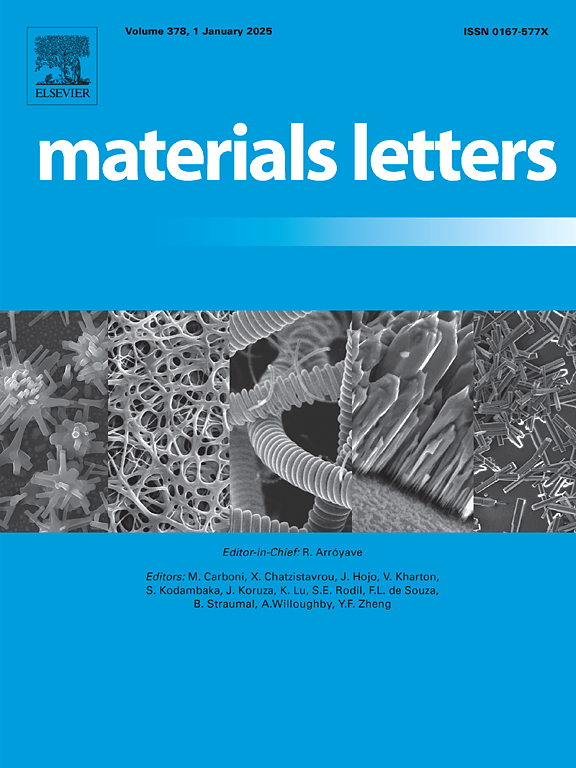Multifaceted benefits of plantain flower derived activated carbon as a composite partner in enhancing the photocatalytic dye detoxification ability of tin tungstate
IF 2.7
4区 材料科学
Q3 MATERIALS SCIENCE, MULTIDISCIPLINARY
引用次数: 0
Abstract
In this study, a heterostructured nanocomposite composed of β-SnWO4 and activated carbon derived from plantain flower (PFAC) was synthesized via a simple soft chemical route. The photocatalytic performance of the composite was evaluated against two model dyes: methylene blue (MB) and methyl orange (MO). The β-SnWO4/PFAC nanocomposite exhibited significantly enhanced photocatalytic degradation efficiencies, achieving 99.8 % for MB and 97.4 % for MO within 45 min under visible light irradiation. The incorporation of PFAC not only improved the surface area and adsorption capacity but also reduced the band gap from 2.8 eV to 2.6 eV, thereby increasing visible light absorption. Furthermore, the formation of a heterojunction between β-SnWO4 and PFAC promoted efficient charge separation and suppressed electron–hole recombination, as evidenced by photoluminescence and UV–Vis analyses. The composite also demonstrated excellent cyclic stability, highlighting its robustness and potential for sustainable environmental remediation.
车前花衍生活性炭作为复合材料在提高钨酸锡光催化脱毒能力方面的多方面益处
本研究采用简单的软化学方法合成了由β-SnWO4和车前草花活性炭组成的异质结构纳米复合材料。用亚甲基蓝(MB)和甲基橙(MO)两种模式染料评价了复合材料的光催化性能。在可见光照射下,β-SnWO4/PFAC纳米复合材料的光催化降解效率显著提高,在45 min内对MB和MO的降解率分别达到99.8%和97.4%。PFAC的掺入不仅提高了材料的表面积和吸附能力,还将带隙从2.8 eV减小到2.6 eV,从而提高了材料的可见光吸收率。此外,通过光致发光和UV-Vis分析可以证明,β-SnWO4和PFAC之间形成异质结促进了有效的电荷分离,抑制了电子-空穴复合。该复合材料还表现出良好的循环稳定性,突出了其鲁棒性和可持续环境修复的潜力。
本文章由计算机程序翻译,如有差异,请以英文原文为准。
求助全文
约1分钟内获得全文
求助全文
来源期刊

Materials Letters
工程技术-材料科学:综合
CiteScore
5.60
自引率
3.30%
发文量
1948
审稿时长
50 days
期刊介绍:
Materials Letters has an open access mirror journal Materials Letters: X, sharing the same aims and scope, editorial team, submission system and rigorous peer review.
Materials Letters is dedicated to publishing novel, cutting edge reports of broad interest to the materials community. The journal provides a forum for materials scientists and engineers, physicists, and chemists to rapidly communicate on the most important topics in the field of materials.
Contributions include, but are not limited to, a variety of topics such as:
• Materials - Metals and alloys, amorphous solids, ceramics, composites, polymers, semiconductors
• Applications - Structural, opto-electronic, magnetic, medical, MEMS, sensors, smart
• Characterization - Analytical, microscopy, scanning probes, nanoscopic, optical, electrical, magnetic, acoustic, spectroscopic, diffraction
• Novel Materials - Micro and nanostructures (nanowires, nanotubes, nanoparticles), nanocomposites, thin films, superlattices, quantum dots.
• Processing - Crystal growth, thin film processing, sol-gel processing, mechanical processing, assembly, nanocrystalline processing.
• Properties - Mechanical, magnetic, optical, electrical, ferroelectric, thermal, interfacial, transport, thermodynamic
• Synthesis - Quenching, solid state, solidification, solution synthesis, vapor deposition, high pressure, explosive
 求助内容:
求助内容: 应助结果提醒方式:
应助结果提醒方式:


